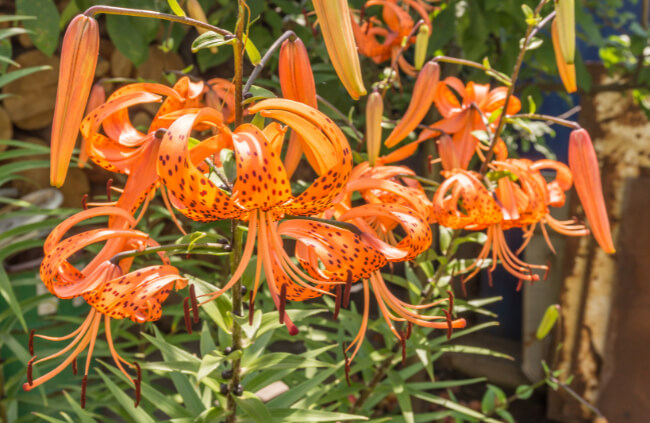Tiger lilies look just as good in swathes as they do planted in potted clumps, and as hardy bulbs they are incredibly easy to grow. If you want to show off without any of the effort, they are definitely the plant for you.
In this guide, we’ll give you all the tools to get started with these iconic lilies, and hopefully set you up for a garden packed with their dramatic flowers.
More...

Family: | Liliaceae |
|---|---|
Genus: | Lilium |
Species: | L. lancifolium |
Common Names: | Tiger Lily |
Origin: | Asia (China, Japan, Korea) and Eastern Russia |
Location: | Outdoor |
Type: | Bulbous perennial |
Growth: | up to 1.5m tall |
Sun requirements: | Full sun |
Foliage Colour: | Green |
Flower Colour: | Speckled orange |
Flowering: | Summer |
Fruits: | None |
Maintenance level: | Medium |
Poisonous for pets: | Highly toxic to cats and dogs |
What are Tiger Lilies?
The tiger lily is a member of the lily family, Lilium lancifolium, but unlike most plain but brightly coloured lilies, this vividly pastel lily is dappled with freckles of black across each petal, which fold back on themselves to create an accessible pollen-rich centre.
Because its flowers form in sequence along a tall bare stem, they are fully visible without interruption from its subtle foliage. This makes them especially useful as ornamental plants in gardens because they require no pruning through spring, summer, or autumn, and continue to flower regardless of whether you deadhead them.
Their only real need for you as a gardener is water to prevent them from drying out completely in the hot summer months.

Edible Uses for Tiger Lilies
While tiger lilies, like all lily species, are very toxic to cats and dogs, they are actually edible for humans. In many Asian cuisines, they are used as an alternative to turnips or potatoes, by roasting the bulbs to produce a soft but slightly sharp flavour that offers an easy base for other flavours.
The flowers are equally edible, and have a brilliantly sweet flavour, wrapped in an overarching taste of spinach. Raw in salads, it adds a soft bite to mixed leaves.
Natural Habitat of Lilium lancifolium
Tiger lilies are native to most parts of eastern Asia, and the extreme east of Russia, where they grow in a wide variety of conditions, from open prairie in full sun to the deep, nutrient-deficient shade of coniferous forests.
Because of their ornamental value, they are now widespread all over the world, where they have seeded everywhere from roadsides to coastlines. Once seeds take hold, they take around two years to form a bulb, which stores energy for flowering, and will continue to thrive in any conditions where it gets adequate rainfall.
For more experimental gardeners looking to take a new approach to lawns, they will even work by plugging bulbs straight into lawns like daffodils, tulips, or camassia bulbs as they aren’t afraid of a little competition, and are quite used to that meadow setting in nature.
How to Grow Tiger Lilies in Australia
Tiger lilies grow best in spots either with good drainage, or competition for moisture. If growing in pots, they will need a well drained potting mix, and plenty of crocks for drainage at the base. In beds or borders, any loose soil is fine.
If you are at all unsure, try to push your finger into the soil. If there is resistance, consider how easily a bulb could expand in those conditions. If there is a lot of moisture, it’s probably too wet for these damp-sensitive plants to thrive.

Best Conditions for Planting Tiger Lilies Outdoors
To grow tiger lilies outdoors, you’ll need to find a position with good drainage, good sun, and reasonable but not plentiful nutrients. Most well-tended gardens will suit tiger lilies to a tee.
Like any lily bulb, they should be planted at three times the depth of the bulb so they have good anchorage in the soil, and remain stable against high winds


Get Your Free Guide:
Master Growing Australian Natives eBook
A Must Have Complete Guide for Every Australian Garden
Get Your Free Guide:
Master Growing Australian Natives eBook
A Must Have Complete Guide for Every Australian Garden
Soil conditions
If you are starting with an open bed or border, dig the entire bed over to a depth of at least 15 cm, making sure to break up any lumps of clay soil, and add garden compost or leaf mould to make sure it is neither too wet, or too free-draining.
Rake the entire surface smooth, and then plant bulbs about 10cm apart in a random pattern so they don’t look too regimented when they flower.
Light conditions
If you have a bright, sunny spot, with about 6 hours of direct sunlight per day, that’s perfect, but provided they never get waterlogged, tiger lilies are quite happy to grow in part shade.
For tiger lilies in pots, light shade is preferable, as pots dry out faster than garden soil, and slightly shaded spots will help to reduce watering frequency.
Water and Moisture
The most important factor when planting tiger lilies is water. They can be baked, parched, or planted alongside running water, but they should never be planted where standing water stays put for more than half an hour.
Still-water will damage most bulbous perennials like tulips or lilies, but tiger lilies are particularly sensitive to over-watering, and bulbs can rot surprisingly fast.
Propagating Tiger Lilies
Tiger lilies can be dug up and divided from clumps as the bulbs duplicate, and bulbils naturally drop to the ground and propagate themselves over time.
Young plants can simply be teased out of loose soil and grown on in pots too, which is by far the simplest way to grow them. However, if you don’t have your own patch of tiger lilies already, it’s worth considering growing them from the bulbils that form at the leaf axil, just above where the leaf joins the main stem.
Tiger lily Propagation from Bulbils
It is possible to grow tiger lilies from seed, but it can take several years for any significant development, and longer still for reliable flowering. So by starting from bulbils (small bulbs that form along the stem, packed with nutrients and hormones to grow new bulbs when they hit the ground) you can easily grow new tiger lily plants from scratch in a matter of months.
In summer, as the plant is flowering, and shortly afterwards, you may notice small red bumps where a leaf meets the stem. These are the bulbils.
All you need to do is remove them by bending them away from the stem and planting directly into a loose compost. Water them in well, and then leave them alone somewhere away from direct sunlight for a few weeks.
They should germinate after 3-4 weeks, and then it's just a matter of waiting. When they are large enough to handle, prick young plants out into individual pots, and grow them somewhere bright, in direct sun, watering once a week, or when the surface soil dries out.
Caring for Tiger Lilies
Once your tiger lilies have established, and flower reliably each year, ongoing care is really quite simple. They are completely winter hardy, so won’t be damaged by frost, and are drought tolerant in summer, but perform much better with regular, but not excessive watering.

Watering Mature Tiger Lilies
Getting the balance of water right for tiger lilies is a fine line but, essentially, if you water when the soil is starting to dry in summer and leave them unwatered through winter, they will thrive.
If it’s rained naturally, don’t water them, as they can be easily over-watered. As a guide, in Southern Australia, we water tiger lilies in our north-facing borders about once a week in summer.
When to Repot
Tiger lilies grown in pots will need to be repotted or divided eventually, as they will spread into a dense clump that outgrows their space; particularly in terracotta or ceramic pots, which they can crack.
If the base of your tiger lilies is within 2 inches of the edge of the pot, it's probably time to tip them out and divide them into two new pots.
Do this in early spring or late winter when fresh growth is starting to show.
Common Tiger Lily Pests and Diseases
Tiger lilies are tough plants that are both resistant to, and resilient against pests and disease, but it’s still worth understanding those that they carry.
Tiger lily Pests
Thankfully, tiger lilies are very rarely subject to any pest damage in Australia. In other parts of the world, a vivid and unmissable red beetle called the red lily beetle, can consume entire plants, and slowly colonises a garden if there are enough lilies to sustain a population.
If you ever notice one of these beetles on your lilies in Australia, report them, squish them, and stop them from spreading.
The only other common pest for tiger lilies in Australia are aphids, which infest the new shoots of young plants. However, a diverse garden will usually be enough protection from this, as aphids prefer nearly all other plants to lilies.
Should you have an aphid infestation, refer to our comprehensive guide on how to get rid of aphids and prevent them from coming back.
Tiger lily Diseases
There are few diseases that affect tiger lilies, but they can carry the mosaic virus, which can spread to other garden plants. They will continue to flower even with an infection, but surrounding plants may succumb to the more adverse effects of mosaic virus.
Frequently Asked Questions About Tiger Lilies

Do tiger lilies grow back every year?
Tiger lilies flower for about one month per year, with several flowers on one stem. After they flower they stop producing and start to develop seeds. Tiger lilies do grow back every year though, so you will get a repeat display in the garden every year after planting them.
Do tiger lilies need to be cut back?
When tiger lilies have finished flowering, usually around the end of summer, their leaves will fade and turn yellow. Allow them to fade back, and when all the green has faded, it will have fed the bulb sufficiently enough for next year.
Cut them back to tidy them up, or allow the foliage to wilt by itself.
Do tiger lilies multiply on their own?
Tiger lilies multiply on their own, as the bulbs duplicate and bulbils plant themselves naturally when the stems fade and drop to the ground. Allowing this process to happen organically will produce a more natural spread of these beautiful orange flowers than any amount of curating you might do as a gardener.
Should I deadhead tiger lilies?
Deadheading tiger lilies does not produce more flowers, so it isn’t necessary, but it will prevent the production of seeds, so helps to focus the plant’s energy on its bulb, making for a better display with next year’s blooms.
Wrapping Up Our Guide to Growing and Caring for Tiger Lilies
Tiger lilies are, despite some picky characteristics, very easy to grow. As long as you give them good free-draining soil for their bulbs, and don’t overwater them, they can spread, seed, and flower year after year, creating natural swathes of highly ornamental blooms in summer.
Like most lilies, they are highly toxic to pets, but unlike other lilies are an edible delicacy for humans, so whether you’re growing them to expand your culinary options, or simply for garden decoration, it's well worth knowing how to grow tiger lilies yourself at home.
Published on June 11, 2023 by Maisie Blevins
Last Updated on October 18, 2024




